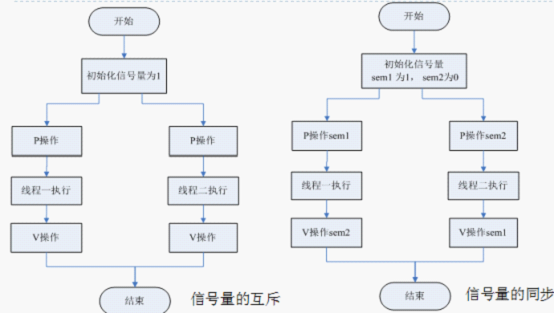3)合并线程:pthread_join
int pthread_join(pthread_t* thread, void **ret);
第一个参数为被等待的线程标识符,第二个参数为一个用户定义的指针,它可以用来存储被等待线程的返回值。这个函数是一个线程阻塞的函数,调用它的函数将一直等待到被等待的线程结束为止,当函数返回时,被等待线程的资源被收回。关于什么是可joinable的线程,参见[3]。
4)通过到斥实现线程同步
(1)声明互斥锁变量:pthread_mutext_t mutex;
pthread_mutex_t为不公开的数据类型,其中包含一个系统分配的属性对象。
(2)互斥锁初始化:pthread_mutex_init(pthread_mutex_t *mymutex, const pthread_mutexattr_t *attr );
第一个参数接受一个指针以初始化为互斥对象,该指针指向一块已分配好的内存区。第二个参数,可以接受一个可选的pthread_mutexattr_t指针。这个结构可用来设置各种互斥对象属性。
(3)锁定互斥锁 :pthread_mutex_lock (&mutex);
pthread_mutex_lock声明开始用互斥锁上锁,此后的代码直至调用pthread_mutex_unlock为止,均被上锁,同一时间只能被一个线程调用执行。
(4)打开互斥锁:pthread_mutex_unlock(&mutex);
示例代码
 View Code
View Code
#include <stdio.h>
#include <pthread.h>
#include <stdlib.h>
#include <unistd.h>
int allTickets= 10; //假设总共还剩余十张票
pthread_mutex_t mutex; //声明互斥锁
void* window1(void* arg)
{
while(allTickets >= 1)
{
pthread_mutex_lock(&mutex); //加锁
if(allTickets >= 1)
{
printf("I am window1:%d\n",allTickets);
allTickets--;
}
pthread_mutex_unlock(&mutex); //对共享资源的访问完后解锁
sleep(1);
}
}
void* window2(void* arg)
{
while(allTickets>=1)
{
pthread_mutex_lock(&mutex);
if(allTickets>=1)
{
printf("I am window2:%d\n",allTickets);
allTickets--;
}
pthread_mutex_unlock(&mutex);
sleep(2);
}
}
int main(void)
{
pthread_t sell1,sell2;
pthread_mutex_init (&mutex,NULL);
pthread_create(&sell1, NULL, window1, NULL);
pthread_create(&sell2, NULL, window2, NULL);
pthread_join(sell1,NULL);
pthread_join(sell2,NULL);
return 1;
}
(5)其他
互斥锁判断上锁:pthread_mutex_trylock()
消除互斥锁:pthread_mutex_destroy()
5)通过信号量实现线程同步
(1)基本概念
信号量本质上是一个非负的整数计数器,它被用来控制对公共资源的访问。当公共资源增加时,调用函数sem_post( )增加信号量。只有当信号量值大于0时,才能使用公共资源,使用后,函数sem_wait( )减少信号量。
和信号量有关的一些函数,它们都在头文件 semaphore.h中定义。信号量的数据类型为结构sem_t,它本质上是一个长整型的数。函数sem_init( )用来初始化一个信号量。它的原型为:
extern int sem_init _P ((sem_t *sem, int pshared, unsigned int value));
sem为指向信号量结构的一个指针;pshared不为0时此信号量在进程间共享,否则只能为当前进程的所有线程共享;value给出了信号量的初始值。
函数sem_post( sem_t *sem )用来增加信号量的值。当有线程阻塞在这个信号量上时,调用这个函数会使其中的一个线程不再阻塞,选择机制同样是由线程的调度策略决定的。
函数sem_wait( sem_t *sem )被用来阻塞当前线程,直到信号量sem的值大于0,解除阻塞后将sem的值减一,表明公共资源经使用后减少。
函数sem_destroy(sem_t *sem)用来释放信号量sem。
示例生产者与消费者
 View Code
View Code
#include <stdio.h>
#include <pthread.h>
#include <semaphore.h>
#include <stdlib.h>
#include <unistd.h>
#define N 20
int k = 0; //保存现有产品数量
sem_t full;
sem_t empty;
pthread_mutex_t mutex;
void* producer(void* arg)
{
while(1)
{
sem_wait(&empty);
pthread_mutex_lock(&mutex);
k++;
printf(" produce one Remaining:%d\n", k);
pthread_mutex_unlock(&mutex);
sem_post(&full);
sleep(1);
}
}
void* consumer(void* arg)
{
while(1)
{
sem_wait(&full);
pthread_mutex_lock(&mutex);
k--;
printf(" consumer one the rest :%d\n",k);
pthread_mutex_unlock(&mutex);
sem_post(&empty);
sleep(1);
}
}
main()
{
pthread_t thread1, thread2, thread3;
sem_init(&full,0,0);
sem_init(&empty,0,N);
pthread_create(&thread1, NULL, producer, NULL);
pthread_create(&thread2, NULL, producer, NULL);
pthread_create(&thread3, NULL, consumer, NULL);
pthread_join(thread1,NULL);
pthread_join(thread2,NULL);
pthread_join(thread3,NULL);
}
注意:要用两个信号量来标示缓冲的大小,这是实现P_C模型的巧妙之处。
(2)图示
(3)函数
sem_init()用于创建一个信号量,并初始化它的值。
sem_wait()和sem_trywait()都相当于P操作,在信号量大于零时它们都能将信号量的值减一,两者的区别在于若信号量小于零时,sem_wait()将会阻塞进程,而sem_trywait()则会立即返回。
sem_post()相当于V操作,它将信号量的值加一同时发出信号来唤醒等待的进程。
sem_getvalue()用于得到信号量的值。
sem_destroy()用于删除信号量。
参考:
【1】 http://www.cnblogs.com/mydomain/archive/2011/07/10/2102147.html
【2】 http://blog.csdn.net/lanmoshui963/article/details/2176376
【3】 http://www.cnblogs.com/mydomain/archive/2011/08/14/2138454.html
【4】 华中科技大学,中山大学PPT

